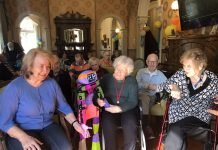Robots assisting with laundry, automated health checks and improved connectivity with carers and family are just some of the features in what is tipped to be Australia’s most technologically advance residential aged care home.
“Seymour Shaw”, due to open in November this year, is the latest addition to aged care provider Thomas Holt’s growing portfolio of Sydney developments.
Located in the Sutherland Shire suburb of Kirrawee, the 120-bed home has been designed entirely around technology in order to increase quality time with care-givers.
“This has meant a total review of everything we do and how we do it,” CEO Alexandra Zammit said.
In addition to robots, circadian rhythm lighting will be installed across six floors to help people to sleep and wake more easily, while a new platform called LiveCare360 will integrate residents’ health and personal care and services.
The platform enables meal ordering and entertainment, streamlined billing and more importantly it records health metrics and data that is captured from sensors placed around the room, in the bed and toilets to give a full picture of a residents’ health and wellbeing each day.
Family members, carers and medical professionals can go into the portal from anywhere and see what the resident has been doing as well as contact the resident directly.
“LiveCare360 is really a concept that looks at providing the ability for a relative or caregiver or interested party to be able to understand the person that they’re contacting in an aged care facility from every angle,” Thomas Holt CIO George Lymbers said in an interview with a CIO website reporter.
Alerts can also be set if health metrics rise or fall outside of ‘normal’, such as a sudden spike in blood pressure.
“That resident information is at the fingertips of the loved one. They can contact that person directly on the bed, or contact the carer who is on duty that night directly,” he said.
“One of the issues in the industry is we can’t get staff and it’s going to get worse and worse. So what can you do? Well you can use technology.”
“You still need to do the biometric measurements. We’re going to get the room to do them.”
Readings will be automatically recorded and fed into a clinical management system that triggers alerts for health professionals and carers, while predictive analytics will be used to foresee potential health events, falls or illnesses, enabling greater prevention of avoidable incidents.
“If we can use and capture that data and create meaningful predictive analytics out of it, we’re able then to know – John in this particular room is on the verge of a UTI or has got one, so he may have a fall soon,” Mr Lymbers said.
“Because the actual signs are so minor, we otherwise wouldn’t have known until they had a fall and then there’d be a test.”
The predictive analytics can also be used to identify early onset of symptoms that can enable proactive measures, such as dietary changes or a full medical review leading to medication changes.
Ultimately, the technology will allow care-givers to spend more quality time with residents.
“Our philosophy is that the reason we’re putting this technology in is so we can concentrate on more compassionate personal care,” Mr Lymbers said.
“When the carer goes in they’re not going to move you around to take a whole load of readings and measurements. A lot of the technology will have already populated that person’s file with data.”
“We’re saying to our carers, you can spend that extra time with the person. You can, say, sit down and brush her hair and talk to her, you can dress her and talk. Not do it on the fly. We want someone to come in and say, let’s have a chat.”
It is understood Live360 will be rolled out to clients using Thomas Holts’ home care services.
Source: CIO









